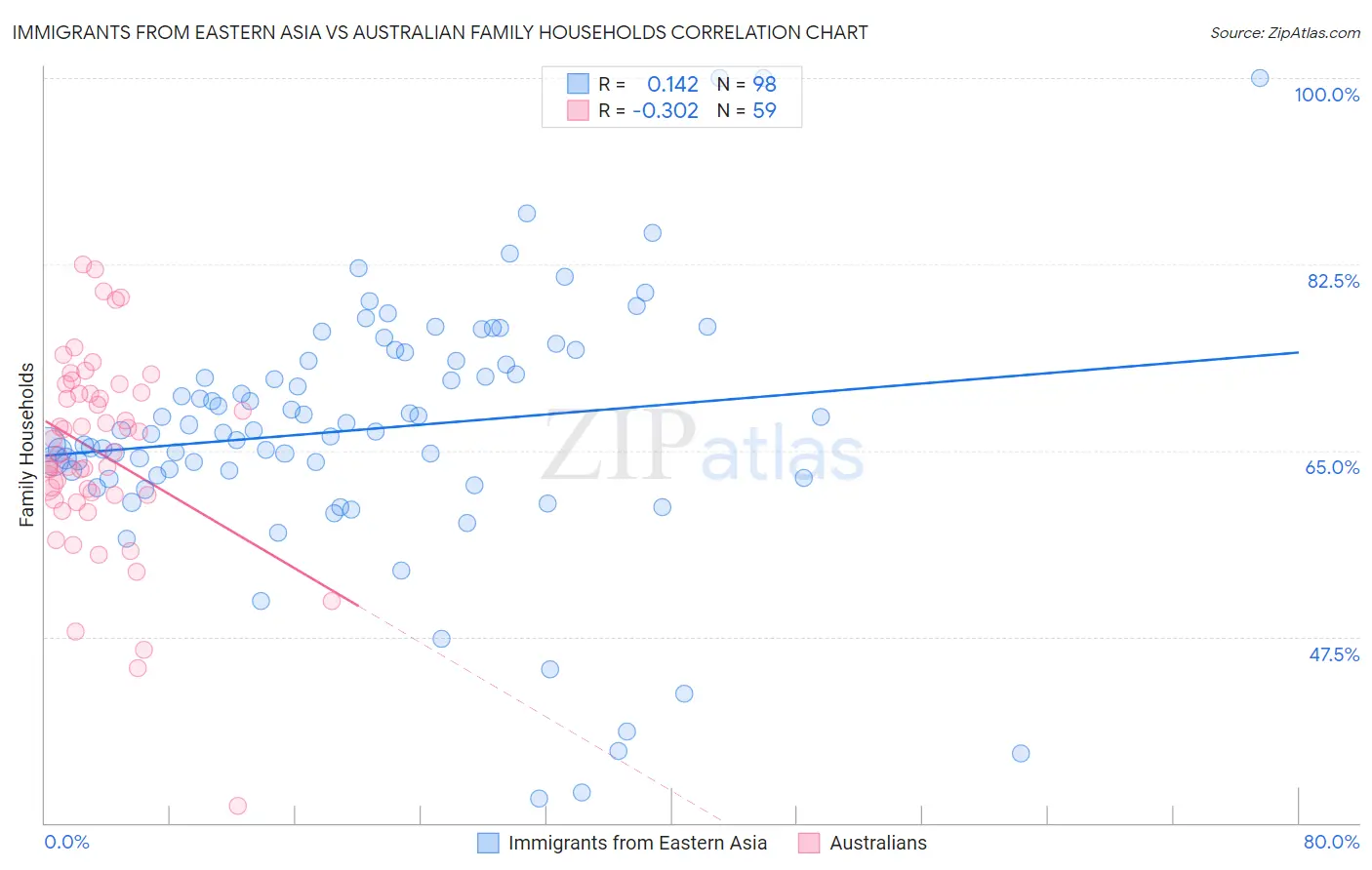Immigrants from Eastern Asia vs Australian Family Households
COMPARE
Immigrants from Eastern Asia
Australian
Family Households
Family Households Comparison
Immigrants from Eastern Asia
Australians
64.9%
FAMILY HOUSEHOLDS
94.4/ 100
METRIC RATING
119th/ 347
METRIC RANK
62.8%
FAMILY HOUSEHOLDS
0.1/ 100
METRIC RATING
284th/ 347
METRIC RANK
Immigrants from Eastern Asia vs Australian Family Households Correlation Chart
The statistical analysis conducted on geographies consisting of 499,398,554 people shows a poor positive correlation between the proportion of Immigrants from Eastern Asia and percentage of family households in the United States with a correlation coefficient (R) of 0.142 and weighted average of 64.9%. Similarly, the statistical analysis conducted on geographies consisting of 224,034,220 people shows a mild negative correlation between the proportion of Australians and percentage of family households in the United States with a correlation coefficient (R) of -0.302 and weighted average of 62.8%, a difference of 3.3%.

Family Households Correlation Summary
| Measurement | Immigrants from Eastern Asia | Australian |
| Minimum | 32.3% | 31.6% |
| Maximum | 100.0% | 82.4% |
| Range | 67.7% | 50.9% |
| Mean | 67.0% | 64.8% |
| Median | 66.8% | 64.9% |
| Interquartile 25% (IQ1) | 62.7% | 60.9% |
| Interquartile 75% (IQ3) | 73.5% | 70.5% |
| Interquartile Range (IQR) | 10.8% | 9.6% |
| Standard Deviation (Sample) | 12.2% | 9.3% |
| Standard Deviation (Population) | 12.1% | 9.2% |
Similar Demographics by Family Households
Demographics Similar to Immigrants from Eastern Asia by Family Households
In terms of family households, the demographic groups most similar to Immigrants from Eastern Asia are Immigrants from Oceania (64.9%, a difference of 0.010%), Hungarian (64.9%, a difference of 0.020%), Dutch (64.9%, a difference of 0.040%), Cherokee (65.0%, a difference of 0.060%), and Hmong (64.9%, a difference of 0.060%).
| Demographics | Rating | Rank | Family Households |
| Immigrants | Jordan | 96.5 /100 | #112 | Exceptional 65.0% |
| Spanish | 96.2 /100 | #113 | Exceptional 65.0% |
| Argentineans | 95.7 /100 | #114 | Exceptional 65.0% |
| Ecuadorians | 95.4 /100 | #115 | Exceptional 65.0% |
| Immigrants | Iraq | 95.4 /100 | #116 | Exceptional 65.0% |
| Cherokee | 95.3 /100 | #117 | Exceptional 65.0% |
| Dutch | 95.1 /100 | #118 | Exceptional 64.9% |
| Immigrants | Eastern Asia | 94.4 /100 | #119 | Exceptional 64.9% |
| Immigrants | Oceania | 94.2 /100 | #120 | Exceptional 64.9% |
| Hungarians | 94.0 /100 | #121 | Exceptional 64.9% |
| Hmong | 93.4 /100 | #122 | Exceptional 64.9% |
| Choctaw | 93.4 /100 | #123 | Exceptional 64.9% |
| Immigrants | Argentina | 92.8 /100 | #124 | Exceptional 64.9% |
| Immigrants | Belize | 92.7 /100 | #125 | Exceptional 64.9% |
| Panamanians | 92.4 /100 | #126 | Exceptional 64.8% |
Demographics Similar to Australians by Family Households
In terms of family households, the demographic groups most similar to Australians are Immigrants from Denmark (62.9%, a difference of 0.040%), New Zealander (62.9%, a difference of 0.050%), Estonian (62.9%, a difference of 0.080%), Mongolian (62.8%, a difference of 0.10%), and British West Indian (62.8%, a difference of 0.13%).
| Demographics | Rating | Rank | Family Households |
| Ottawa | 0.3 /100 | #277 | Tragic 63.0% |
| Immigrants | Belgium | 0.2 /100 | #278 | Tragic 63.0% |
| Immigrants | Yemen | 0.2 /100 | #279 | Tragic 63.0% |
| Immigrants | Bulgaria | 0.2 /100 | #280 | Tragic 63.0% |
| Estonians | 0.2 /100 | #281 | Tragic 62.9% |
| New Zealanders | 0.1 /100 | #282 | Tragic 62.9% |
| Immigrants | Denmark | 0.1 /100 | #283 | Tragic 62.9% |
| Australians | 0.1 /100 | #284 | Tragic 62.8% |
| Mongolians | 0.1 /100 | #285 | Tragic 62.8% |
| British West Indians | 0.1 /100 | #286 | Tragic 62.8% |
| Latvians | 0.1 /100 | #287 | Tragic 62.8% |
| Immigrants | Uganda | 0.1 /100 | #288 | Tragic 62.7% |
| Immigrants | Nepal | 0.1 /100 | #289 | Tragic 62.7% |
| Immigrants | Grenada | 0.0 /100 | #290 | Tragic 62.6% |
| U.S. Virgin Islanders | 0.0 /100 | #291 | Tragic 62.6% |